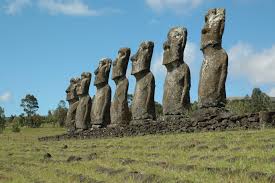Easter Island:

New research reveals Easter Island’s moai statues were “walked” upright using ingenious engineering, not dragged or rolled.
- It is a Polynesian island located in the southeastern Pacific Ocean.
- Named Rapa Nui by its earliest residents, it is one of the most isolated inhabited islands in the world.
- It is a special Chilean territory situated about 3,540 km to the west of Chile and about 1,900 km to the east of Pitcairn Island.
- It covers a total area of 163.6 sq.km.
- It is a small, triangular-shaped volcanic island. It is about 24 km in length and has a maximum width of about 12 km at its widest point.
- The island comprises three extinct volcanoes, namely Terevaka, Poike, and Rano Kau.
- It faces a tropical rainforest climate.
- UNESCO named Easter Island a World Heritage Site on March 22, 1996, and major parts of the island have been protected under the Rapa Nui National Park.
- Rapa Nui is famous for its large megalithic statues called moai.
- They are shaped like large human heads and erected on stone pedestals.
- They are famous for their carved heads and “Pukao,” a hat-like covering made from a soft red stone.
- Some moai stand 40 feet tall and weigh 75 tonnes.
- They were carved in volcanic stone at quarries and then moved to their current locations across the island.
- Scholars believe the Rapa Nui people built the moai between the 13th and the 16th centuries and represented their revered ancestors.
- Over 900 moai have been found on the island to date.




